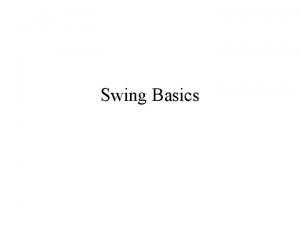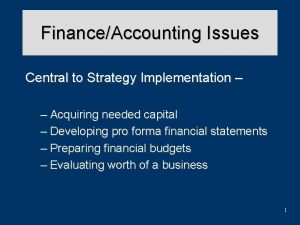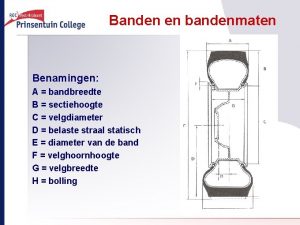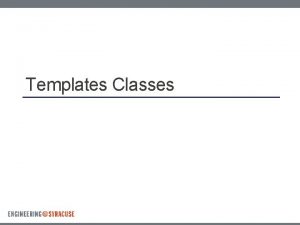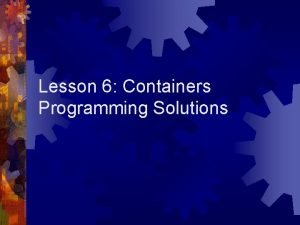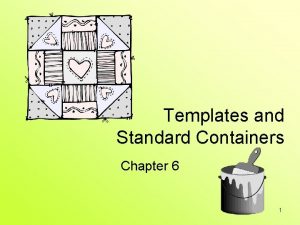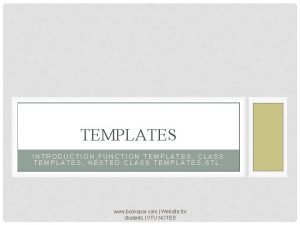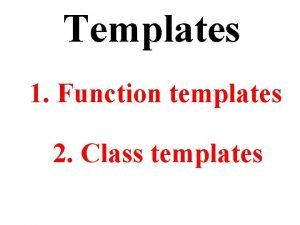Templates Containers Containers Containers are classes which implement












- Slides: 12

Templates Containers

Containers • Containers are classes which implement data structures containing objects of other classes: • stacks, lists, queues, … • Often the logic necessary to manage a container is independent of its contents type, using the type only symbolically. These containers may be implemented with templates to yield a generic container. • If an operation of the generic type is needed by the container, say assignment or comparison, then the type used to instantiate the container must provide it. Otherwise, compilation will fail. • Example: if we expect to support binary search on a generic array of objects: array<T> my. Array, then the type T will need to support assignment and comparison so we can sort the array.

Container Types Containers are classified as either: • Homogeneous Containers hold only one type of object. They generalize an array of primitive types. • Heterogeneous Containers hold more than one type of object, usually. • • If a container expects a reference to a base class object, it will accept a reference to any type which is derived from the base class. Upward type compatibility is the basis for flexible run-time creation and management of objects.

Template Container Types • If we implement a container with templates, it will be homogeneous; if we instantiate it with a class with no derivations or with a primitive type, e. g. : array<char> my. Homogeneous. Array; • If, however, we instantiate the container with pointers to the base class of a derivation hierarchy, then the same design yields a heterogeneous container; e. g. : array<my. Base. Class*> my. Heterogeneous. Array; The moral of this story is that you should always design template containers as implicitly homogeneous, allowing instantiation to determine the container type.

Container Semantics • Containers are said to have either: • Value semantics: Objects are copied into the container. • Reference semantics: The container is passed a reference or pointer to an external object.

Reference Semantics • Container holds references to objects; e. g. , pointers, C++ references, or handles. • An object can be “in” more than one container simultaneously. • Insertion does no copying. • When containers are destroyed, their objects are not automatically destroyed. • So you have to manage those resources without help from the container.

Value Semantics • Container holds the objects themselves. • No object lives in more than one container. • Objects are copied into the container, so the container owns its objects. • All contained objects must be the same size. • Types must supply copy and assignment semantics. • When the container is destroyed, the objects are also destroyed.

Container Semantics • It is easy to simulate reference semantics by using containers designed with value semantics, but holding reference objects; e. g. : array<my. Objects*> Collection. Of. Pointers • The moral of this story is that you should always design containers with value semantics. If the client wants reference semantics, that’s easy to arrange by using references to objects. • The client then takes responsibility to manage the references properly.

Container Iterators • Iterators are objects designed to traverse a specific container type. • Often the container must grant the iterator friendship status or provide member accessor functions designed to allow the iterator to do its job. • A container/iterator class pair generalizes the operations of an array/pointer pair for primitive types. • The iterator constructor makes the iterator “point” to an object in the container. • Often, the iterator has knowledge and access necessary to traverse some, perhaps complex, internal structure in the container, contained object-by-object.

Iterator Issues • Either the designer or client must take care not to destroy a container, or change allocations in a container, if it has active iterators. The result would be a dangling reference. • We will see later that it is easy to create invalid iterators on std: : vector objects by inserting or removing elements. • Iterators are especially useful in cases when a container may need to have more than one simultaneous traversal. • This is a common need, for example, when implementing graph algorithms. • There may also be more than one type of useful traversal, so iterators can be designed for each type. • Depth first search and breath first search on graphs are examples.

Conclusion • Virtually everything we’ve discussed in this presentation is a part of the design or use of the Standard Template Library (STL). • We will see all of these illustrated with examples throughout this course.

 Insidan region jh
Insidan region jh Classes salsa and swing implement an interface dance
Classes salsa and swing implement an interface dance Classes e sub classes de palavras
Classes e sub classes de palavras Pre ap classes vs regular classes
Pre ap classes vs regular classes These are mental templates by which we organize our worlds.
These are mental templates by which we organize our worlds. Giving priority to the goals of one's group
Giving priority to the goals of one's group Reiser implement
Reiser implement Permanent product recording data sheet
Permanent product recording data sheet Truetracker
Truetracker Acquiring capital to implement strategies
Acquiring capital to implement strategies Implement strategies management issues
Implement strategies management issues Implement profiel banden
Implement profiel banden Eschew the implement of correction and vitiate the scion
Eschew the implement of correction and vitiate the scion

